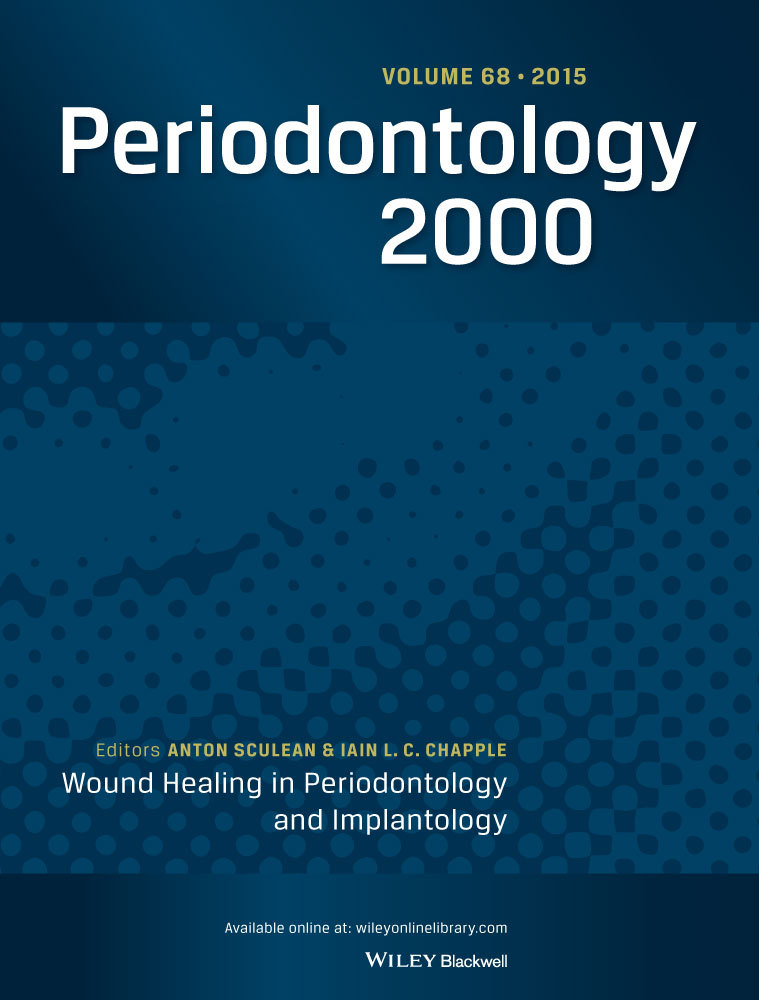Periodontitis and risk of cancer: Mechanistic evidence
IF 17.5
1区 医学
Q1 DENTISTRY, ORAL SURGERY & MEDICINE
引用次数: 0
Abstract
This review aims to critically analyze the pathways of interaction and the pathogenic mechanisms linking periodontitis and oral bacteria with the initiation/progression of cancer at different body compartments. A higher risk of head and neck cancer has been consistently associated with periodontitis. This relationship has been explained by the local promotion of dysbiosis, chronic inflammation, immune evasion, and direct (epi)genetic damage to epithelial cells by periodontal pathobionts and their toxins. Epidemiological reports have also studied a possible link between periodontitis and the incidence of other malignancies at distant sites, such as lung, breast, prostate, and digestive tract cancers. Mechanistically, different pathways have been involved, including the induction of a chronic systemic inflammatory state and the spreading of oral pathobionts with carcinogenic potential. Indeed, periodontitis may promote low-grade systemic inflammation and phenotypic changes in the mononuclear cells, leading to the release of free radicals and cytokines, as well as extracellular matrix degradation, which are all mechanisms involved in carcinogenic and metastatic processes. Moreover, the transient hematogenous spill out or micro-aspiration/swallowing of periodontal bacteria and their virulence factors (i.e., lipopolysaccharides, fimbriae), may lead to non-indigenous bacterial colonization of multiple microenvironments. These events may in turn replenish the tumor-associated microbiome and thus influence the molecular hallmarks of cancer. Particularly, specific strains of oral pathobionts (e.g., Porphyromonas gingivalis and Fusobacterium nucleatum) may translocate through the hematogenous and enteral routes, being implicated in esophageal, gastric, pancreatic, and colorectal tumorigenesis through the modulation of the gastrointestinal antitumor immune system (i.e., tumor-infiltrating T cells) and the increased expression of pro-inflammatory/oncogenic genes. Ultimately, the potential influence of common risk factors, relevant comorbidities, and upstream drivers, such as gerovulnerability to multiple diseases, in explaining the relationship cannot be disregarded. The evidence analyzed here emphasizes the possible relevance of periodontitis in cancer initiation/progression and stimulates future research endeavors.牙周炎与癌症风险:机制证据
本综述旨在批判性地分析牙周炎和口腔细菌与人体不同部位癌症的发生/发展之间的相互作用途径和致病机制。头颈部癌症的高风险一直与牙周炎有关。牙周致病菌及其毒素在局部促进了菌群失调、慢性炎症、免疫逃避以及对上皮细胞的直接(外)遗传损伤,从而解释了这种关系。流行病学报告还研究了牙周炎与其他远处恶性肿瘤(如肺癌、乳腺癌、前列腺癌和消化道癌症)发病率之间可能存在的联系。从机理上讲,这涉及不同的途径,包括诱发慢性全身炎症状态和具有致癌潜力的口腔病原体的传播。事实上,牙周炎可促进低度全身炎症和单核细胞的表型变化,导致自由基和细胞因子的释放,以及细胞外基质的降解,这些都是致癌和转移过程中的相关机制。此外,牙周细菌及其毒力因子(即脂多糖、缘膜)的短暂血源性溢出或微吸入/吞咽可能导致非本地细菌在多个微环境中定植。这些事件可能反过来补充肿瘤相关微生物群,从而影响癌症的分子特征。特别是,口腔病原菌的特定菌株(如牙龈卟啉单胞菌和核酸镰刀菌)可能通过血源性和肠道途径转移,通过调节胃肠道抗肿瘤免疫系统(即肿瘤浸润 T 细胞)和增加促炎/致癌基因的表达,与食管、胃、胰腺和结直肠肿瘤的发生有关。归根结底,在解释这种关系时,不能忽视常见风险因素、相关合并症和上游驱动因素(如对多种疾病的老年易感性)的潜在影响。本文分析的证据强调了牙周炎在癌症发生/发展过程中可能存在的相关性,并激励着未来的研究工作。
本文章由计算机程序翻译,如有差异,请以英文原文为准。
求助全文
约1分钟内获得全文
求助全文
来源期刊

Periodontology 2000
医学-牙科与口腔外科
CiteScore
34.10
自引率
2.20%
发文量
62
审稿时长
>12 weeks
期刊介绍:
Periodontology 2000 is a series of monographs designed for periodontists and general practitioners interested in periodontics. The editorial board selects significant topics and distinguished scientists and clinicians for each monograph. Serving as a valuable supplement to existing periodontal journals, three monographs are published annually, contributing specialized insights to the field.
 求助内容:
求助内容: 应助结果提醒方式:
应助结果提醒方式:


